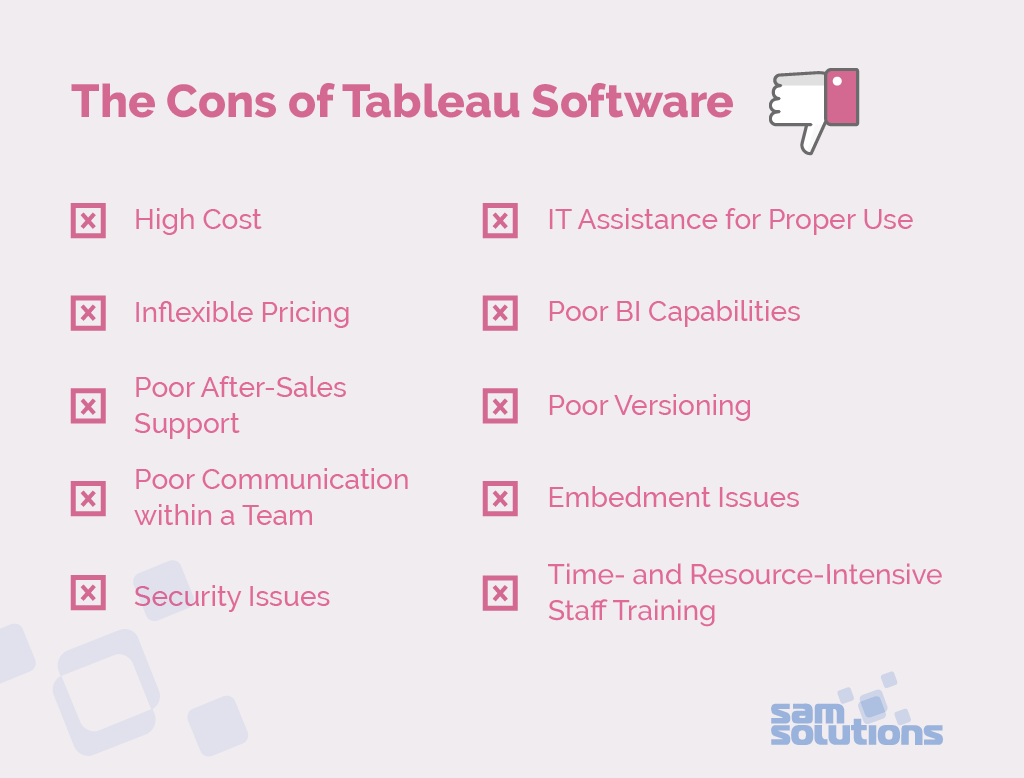Among the multiple data visualization products in the market, there is one solution that certainly stands out — Tableau Software. An application for translating raw data into valuable insights, it has provided an unparalleled user experience for 16+ years. While there are pros and cons of Tableau software, Gartner’s 2019 Magic Quadrant for Business Intelligence and Analytics Platforms rates it as a leader for seven consecutive years.
Why Opt for Visualization
Why do companies tend to step over the bounds of traditional written, audio and video data sources and go for data visualizing tools? It would seem that the modern human is far more advanced as to be affected by a colorful eye-catching image. And yet, psychological research shows that 90% of all the information that people perceive comes from their sense of sight. And the simpler the way the information is put, the higher the chances that it is processed.
Apparently, transforming analytical information into optical form facilitates its digestion and understanding and allows to uncover valuable data. This may work in companies’ favor if they leverage such a peculiarity correctly, as it allows enhancing business processes and improving employees’ performance. So, an increasing number of companies turned to data visual depiction, and big market players have developed their solutions for stats visualization, such as:
- Microsoft
- Qlik
- SAP
- IBM
- Salesforce
- Oracle
- Others
What Is Tableau Software?
Not only does the Gartner rate Tableau analytics platform highly, but there are numerous user testimonials that assert that its visuals are the number one in the market and consider this software the enterprise standard. What does Tableau visualization software do and why is it so specific that many businesses have come to incorporate it into their daily operations?
A powerful business intelligence tool for analytics visualizing, Tableau casts the results in numerous vivid forms to get better insight.
Healthcare, insurance, manufacturing, education, marketing, wholesale and retail, and other business domains have been already making an extensive use of the insightful data visualization performed by Tableau.
The solution’s functionality is not limited by the graphic information representation; there is also a heap of work under the surface. Indeed, the application makes requests to the cloud and relational databases, spreadsheets and OLAP cubes for the required statistical data, and then parses, categorizes and correlates it to generate a comprehensive analytical report. Tableau has both desktop and online versions, which enables access to software data in the cloud or on premises.
If your company seeks to improve analytics and get the most out of what data rendition offers, you must have your sights set on Tableau data visualization software. However, before being taken with its remarkable visualizing capabilities, learn the limitations of Tableau as they pertain to your business — check out our Tableau reviews.
The Pros of Tableau Software

Although the ultimate quality visualization of interactive data overshadows all other Tableau advantages, the list of the benefits that the tool brings to businesses is quite long.
1. Remarkable Visualization Capabilities
Of course, unparalleled capabilities of visualizing information is on top the list of Tableau software benefits. The application’s data visualizing quality is superior to what Tableau software competitors offer. Even the products of traditional business intelligence vendors, such as Oracle Data Visualization or IBM’s products for data rendition, cannot compete with the illustration and design quality that Tableau provides.
It converts unstructured statistical information into comprehensive logical results, which are fully functional, interactive and appealing dashboards. They are available in several types of graphics and are easy to use in business affairs.
2. Ease of Use
The tool’s intuitive manner of creating graphics and a user-friendly interface allow non-dev users to utilize the basic app’s functionality to the fullest. Users arrange raw data into catchy diagrams in a drag-and-drop way, which facilitates information analyzing and eliminates the need for the help of an IT department for pattern building.
Lay users can enjoy the capabilities that Tableau offers for stats parsing, such as dashboard development, etc., without in-depth training. However, to get into the solution’s capabilities, deeper knowledge is a must. Also, the close involvement of IT specialists is a necessity if a company seeks to expand the solution’s functionality.
3. High Performance
Apart from its high visualization functionality, users rate its overall performance as robust and reliable. The tool also operates fast even on big data, which makes its powerful performance an important point in the list of the advantages of Tableau.
4. Multiple Data Source Connections
The software supports establishing connections with many data sources, such as HADOOP, SAP and DB Technologies, which improves data analytics quality and enables the creating of a unified, informative dashboard. Such a dashboard grants access to the required information for any user.
5. Thriving Community and Forum
The number of Tableau fans who invest their expertise and skills in the community increases steadily. Business users can beef up their knowledge on data parsing and reporting and get many useful insights in this community. Also, forum visitors are ready to help settle any user issues and to share their experience.
6. Mobile-Friendliness
And the last one in our list of core Tableau benefits, there is an efficient mobile app available for IOS and Android. It adds mobility to Tableau users and allows them to keep statistics at their fingertips, as well as it supports full functionality that a Desktop and Online versions have.
Read also: A Mobile App: Why Your Business Needs It
The Cons of Tableau Software

Despite its superior visualizing and designing capabilities and its other advantages, Tableau’s limitations are quite numerous, which is why they should be taken into serious consideration.
1. High Cost
Tableau is not the most expensive visualization software, especially compared to such business intelligence giants as Oracle’s and IBM’s solutions. All the same, the license is quite costly for most small to medium companies, which makes it one of the considerable Tableau’s disadvantages. Also, the software requires proper deployment, implementation, maintenance and staff training that come at a sizeable price. Therefore, its high cost makes Tableau the choice of primarily large businesses.
2. Inflexible Pricing
Tableau’s sales team is not flexible enough to provide a case-by-case approach for their customers. Ignoring the fact that each company has its own unique requirements to the visualization tool package, the Tableau sales model requires clients to purchase the extended license from the start. As a result, a lot of companies that use Tableau arrive at the conclusion that they don’t need all their licensed features. They would prefer buying a set of required ones and scale them if necessary.
3. Poor After-Sales Support
On multiple message boards, users complain that Tableau software lacks proper after-sales maintenance. If a customer has a software performance problem, the support team doesn’t settle the matter by investigating the problem’s root and eliminating it. The best they do is to advise purchasing a feature, which will compensate for their software’s shortcoming.
4. Security Issues
Since visualizing solutions manipulate some confidential data, the vendors draw special attention to security enhancement. Despite Tableau ’s deep concern for information safety, it fails to provide centralized data-level security. It just allows establishing a row-level security, which stipulates that every user has his/her own account. A great number of accounts increases the chances that the system may be hacked.
5. IT Assistance for Proper Use
Although the software allows for certain ease in its routine application, Tableau still requires significant involvement of an IT department in its further configuration and basic functionality expansion. Many operations require the creation of SQL queries, which is impossible without using the services of a skilled developer. Even though untrained business users may leverage the solution, they can not get the best out of it without the assistance of IT.
6. Poor BI Capabilities
As previously mentioned, the tool provides best-in-class information visual interpretation. However, it lacks functionality required for a full-fledged business intelligence tool, such as large-scale reporting, the building of data tables and static layouts.
Also, the solution has a limited capacity for result sharing. Its notification functionality is quite simple, and only an admin, not end-users, can configure scheduled email subscription. A piece of code in Python allows us to set robust trigger-based notifications, but the vendor does not support the option.
7. Poor Versioning
Only recent Tableau versions support revision history, while for the older ones, software rolling back is impossible.
8. Embedment Issues
Although the vendor claims that its tool can be easily embedded into any business IT landscape, in reality, the solution’s capabilities do not allow for a smooth embedment. Seamless Tableau’s integration into a company’s product is a real challenge from both the financial and technical points of view.
9. Time- and Resource-Intensive Staff Training
Basic use of the application does not demand hyper-focused knowledge in Tableau. However, the tool’s visualization potential is nearly unlimited, while the learning curve is incredibly steep for non-analyst users. Getting to know all of the tool’s capabilities without comprehensive employee training is nearly impossible. The learning part alone, on both the development and consumption side, may take weeks or months, before one can make the best use of the tool’s functionality and get an immense benefit from it. At the same time, it increases the cost of ownership significantly.
Think Through Before Deciding on Tableau
As in the case of any other software, there are certain advantages and disadvantages of Tableau. So, the first point is to perform the analysis of its pros and cons before purchasing the tool for personal or business use. The solution does its primary job, which is statistics visualization, admirably, and big players such as PepsiCo, Skyscanner and ExxonMobil have come onboard. However, its weak capability to handle analytical results in the way that many BI tools do prevents it from being the industry standard for many companies.



















 The Latest 15 Information Technology Trends in 2024
The Latest 15 Information Technology Trends in 2024 Top 10 Embedded Software Development Tools
Top 10 Embedded Software Development Tools IaaS vs. PaaS vs. SaaS: What’s the Difference?
IaaS vs. PaaS vs. SaaS: What’s the Difference? 10 Examples of Predictive Analytics
10 Examples of Predictive Analytics





